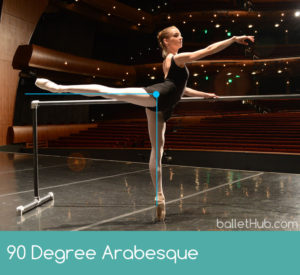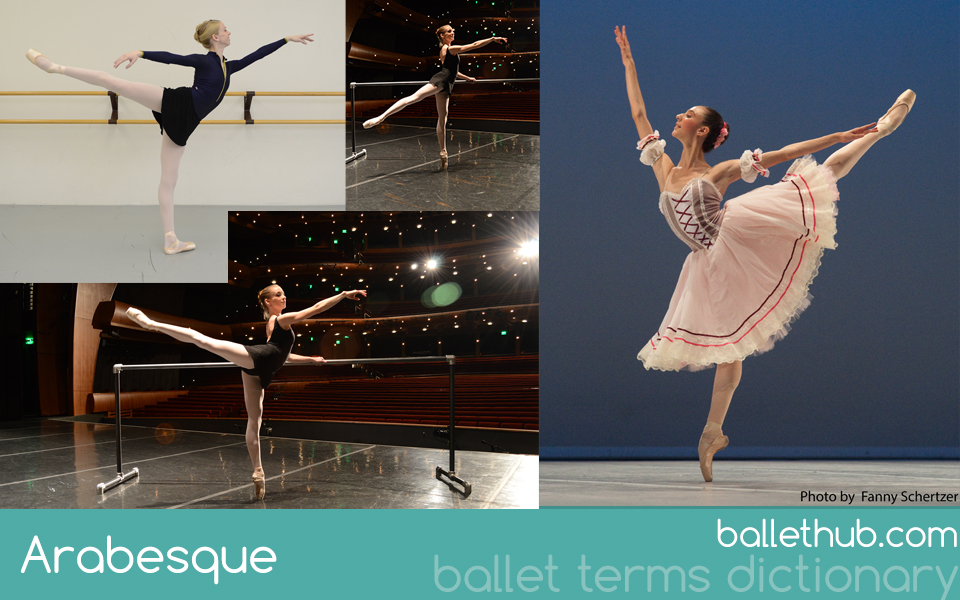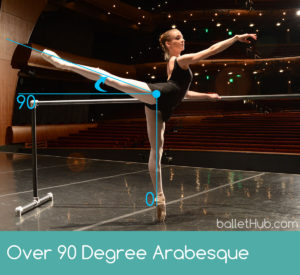In ballet, arabesque is a position where the body is supported on one leg, with the other leg extended directly behind the body with a straight knee.
The standing leg can be straight or in plie, but the back leg must always be straight. Arabesque can be found in almost every aspect of a ballet, both contemporary and classical, as well as other dance forms. Arabesque can be done with the back leg either on the ground (a terre) or raised in the air (en l’air).
Different Arabesque Positions
Arabesque has several different versions, all defined by the position of the dancer’s arms. The one constant is that the dancer must have a straight leg directly behind them, or it is not an arabesque. The different positions that can be done are first arabesque, second arabesque or third arabesque.
First Arabesque
First arabesque is when a dancer in arabesque has the arm that is on the same side as the supporting leg extended out in front of their body, with the other arm extended side or towards the diagonal back.
Second Arabesque
Second arabesque is when a dancer in arabesque has the arm that is on the same side as the back leg extended out in front of their body, with the arm on the side of the supporting leg to the side or diagonal back.
Third Arabesque
Third arabesque is when a dancer in arabesque now has both arms extended in front of the body, with the arm on the same side as the supporting leg slightly higher than the other so the hand is anywhere between the top of their head to a foot above their head. The arm on the side of the leg in arabesque should never move higher than the shoulders.
Different Heights in Arabesque
An arabesque can be done at almost any height where the back foot is off the floor. Higher does not mean better! Past 90 degrees, many dancers begin to sacrifice quality for extra height by opening their hips toward the side.
Low
Sometimes a teacher or choreographer may ask for a dancer to do a “low arabesque.” This usually means around 20 degrees. Much lower, and the step may not show well from a distance.
45 Degrees
A very common height, a 45 degree arabesque is quite common in variations, quick, and slow movement. Since 45 degrees is just half of 90 (in the middle between directly horizontal and directly vertical), it is easier for dancers to know where that height is since it’s an actual measure, and not just a description. This also makes for smoother corps work.
90 Degrees
 The next height typical for arabesques doubles straight to 90 degrees. There isn’t much in between because it doesn’t look deliberate enough. Slightly below 90, and it may look like the dancer can’t get an arabesque to 90.
The next height typical for arabesques doubles straight to 90 degrees. There isn’t much in between because it doesn’t look deliberate enough. Slightly below 90, and it may look like the dancer can’t get an arabesque to 90.
Slightly above 45, it may look like a sloppy or over-exagerated 45 degree arabesque!
90 degrees is often considered the “target” arabesque for many reasons.
- It is very easy to tell if an arabesque is exactly at 90 degrees or not. If it is parallel with the ground, the dancer looks like they are at 90.
- It looks very clean. Line of corps dancers all at 90 (Giselle 2nd act for example) looks very deliberate and uniform. Audiences love this!
- At 90 degrees, there are other things you can do to improve the overall look that don’t involve lifting your leg higher. For example, keep your back more upright, or squaring your hips more. Being able to understand this idea is considered an advanced level way of thinking about technique and measure of quality since it doesn’t involve the obvious “get your leg higher!”
Over 90
Past 90 degrees in an arabesque is common too, but is often reserved when a dancer is featured alone or for the ballerina with her partner.
Because an arabesque gets considerably harder to do correctly past 90 due to average limitation in hips, asking an entire corps to hit a certain degree above 90 is asking for trouble!
Wack!
Every so often, a choreographer wanting an explosive look will ask a dancer to wack their arabesque! This simply means to quickly brush their leg back and try to get their leg as high as they can, often knowingly asking the dancer to sacrifice hip position.
A student focusing on correct technique should never be asked to “wack their leg,” as it truly encourages bad technique and breaks the look of control and classicism. But, in stylized choreography, it definitely has a place.
Quality Arabesque
No matter if in class or on stage, a ballet dancer should never forget the basic technique for an arabesque which should always include turned out and straight legs. Every dancer, especially advanced, knows their “maximum arabesque” height where quality isn’t sacrificed. And the even more advanced know when to use it for the most effect.


